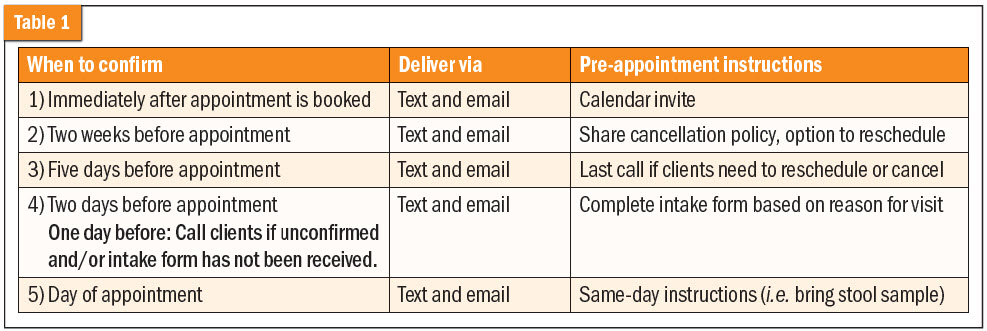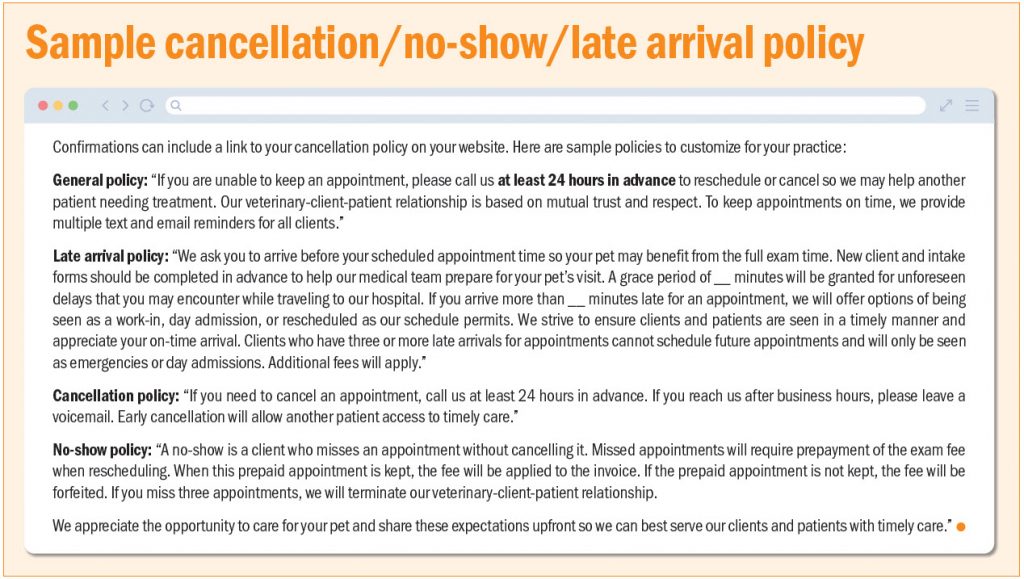
Tired of empty exam rooms from inconsiderate clients? The right confirmations sent at the right times help reduce no-shows and late arrivals. With an industry average 11 percent no-show rate, a three-doctor practice could lose $198,000 annually.1 If you have had enough, revamp your confirmation strategy with these steps:
Send a series of appointment confirmations
Clients will get up to five reminders, depending on how far in advance they book appointments. A pet owner who schedules a checkup three weeks ahead will get five confirmations, while a client who books a same-day sick pet appointment will get one (See: Table 1). Confirmations should include:
- Patient name
- Time and date of appointment
- Calendar invite so clients may add appointments to their cell phones and digital calendars
- Pre-appointment instructions (what to bring, stool sample, full bladder, fasting, etc.)
- Intake form based on reason for visit
- Link to cancellation/no-show/late policies
- Collect deposits if applicable
- Link to driving directions for new clients
- Link to information on preventive care plans if available
- Request to confirm or reschedule


Send intake forms based on the reason for visit
Use appointment type templates in your PIMS, such as wellness, urgent care, sick patient, puppy/kitten, progress exam, and technician appointments, which will trigger the corresponding confirmation and intake form through your third-party reminder service. A client with a wellness appointment will get a wellness intake form, while a pet owner who books a dental procedure will receive an anesthetic consent.
Intake forms will save 10 to 15 minutes technicians and assistants previously spent asking history questions at the start of appointments. Veterinarians and technicians can review clients’ forms before exams and ask follow-up questions, resulting in more efficient use of exam time. Rolling Hills Veterinary Service in Bethel, Ohio, cut surgical check-in time in half by texting and emailing preadmission instructions and anesthetic consents in advance.2
Depending on your third-party reminder service, forms may write back to your PIMS, or you may need to manually save them in records. If forms do not write back, set up an email address such as records@. This lets you quickly locate completed forms rather than risk messages getting buried in your info@ inbox.
Decide whether to collect deposits for high-risk appointments
New client appointments and procedures are the greatest no-show risk. Consider whether new clients will pay exam fees upfront, and existing clients will prepay a percentage of procedure fees. Create a policy to define whether deposits are refundable, which cancellation reasons will be accepted, and how far in advance appointments must be cancelled.
Know your state’s law on deposits and partial payments when setting your policy. To comply, you may need to post refund policies. In California, businesses are required to post refund policies unless they offer a full cash refund, exchange, or store credit within seven days of the purchase or payment date.3

Avoid the term “deposit” because clients may assume they will get money back when pets are returned in good condition. Instead, use the terms appointment or surgical “reservation fee” or “prepayment.”
Explain prepayments when scheduling new client appointments and procedures. Say this:
“[Client name], we look forward to meeting you and on [date, time] for a new patient exam. We will collect $[fee] as a new client appointment reservation fee. This amount will be applied to your first visit with us. If you are unable to keep this appointment, we ask that you call us at least 24 hours in advance to reschedule or cancel. Appointments cancelled with less than 24-hour notice are not refund-eligible. You will receive a text today with your confirmation and an invoice for the new client appointment reservation fee. Click on the invoice to view and pay today. As your appointment date nears, you’ll get reminders with pre-appointment instructions. If you have questions before your visit, please call or text us. We’re excited to meet you and [pet name]!”
Because credit card merchant fees are higher when taking payments over the phone (defined as “card not present”), use app and text-to-pay links or swipe cards if booking procedures in-person at checkout.
When you create a confirmation strategy that includes multiple reminders and provides pre-appointment instructions, you will train clients to show up on time and create mutually beneficial relationships.
Wendy Myers, CVJ, knows confident conversations drive patient and practice health. As founder of Communication Solutions for Veterinarians, she teaches practical skills through online courses, onsite consulting, and conferences. Myers’ experience as a partner in a specialty and emergency hospital helped her understand issues that owners and managers face. Learn how Myers can train your team at the Communication Solutions for Veterinarians website.
References
- Myers W. 4 Ways to End the No-Show Crisis. Available at: https://csvets.com/no-show-crisis/. Accessed June 20, 2024.
- How Otto Flow Helped Rolling Hills Cut Time Spent on Confirmation Calls and Surgery Check-Ins in Half. Available at: https://otto.vet/how-otto-flow-helped-rolling-hills-cut-time-spent-on-confirmation-calls-and-surgery-check-ins-in-half/. Accessed June 20, 2024.
- Customer Returns and Refund Laws by State. Available at: https://www.findlaw.com/consumer/consumer-transactions/customer-returns-and-refund-laws-by-state.html. Accessed June 20, 2024.
- 22 Business Phone Statistics. Numa. Available at: https://www.numa.com/blog/22-business-phone-statistics. Accessed June 20, 2024.

